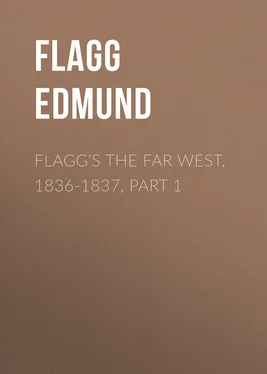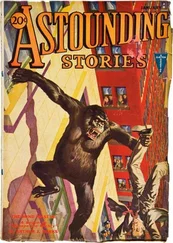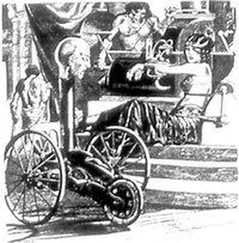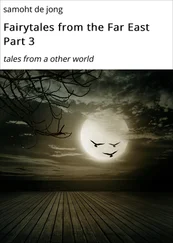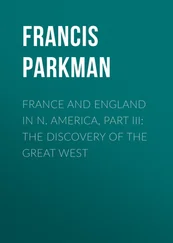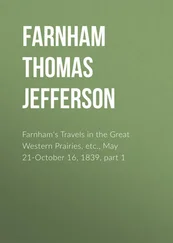Edmund Flagg - Flagg's The Far West, 1836-1837, part 1
Здесь есть возможность читать онлайн «Edmund Flagg - Flagg's The Far West, 1836-1837, part 1» — ознакомительный отрывок электронной книги совершенно бесплатно, а после прочтения отрывка купить полную версию. В некоторых случаях можно слушать аудио, скачать через торрент в формате fb2 и присутствует краткое содержание. Издательство: Иностранный паблик, Жанр: foreign_antique, foreign_prose, Путешествия и география, на английском языке. Описание произведения, (предисловие) а так же отзывы посетителей доступны на портале библиотеки ЛибКат.
- Название:Flagg's The Far West, 1836-1837, part 1
- Автор:
- Издательство:Иностранный паблик
- Жанр:
- Год:неизвестен
- ISBN:нет данных
- Рейтинг книги:4 / 5. Голосов: 1
-
Избранное:Добавить в избранное
- Отзывы:
-
Ваша оценка:
- 80
- 1
- 2
- 3
- 4
- 5
Flagg's The Far West, 1836-1837, part 1: краткое содержание, описание и аннотация
Предлагаем к чтению аннотацию, описание, краткое содержание или предисловие (зависит от того, что написал сам автор книги «Flagg's The Far West, 1836-1837, part 1»). Если вы не нашли необходимую информацию о книге — напишите в комментариях, мы постараемся отыскать её.
Flagg's The Far West, 1836-1837, part 1 — читать онлайн ознакомительный отрывок
Ниже представлен текст книги, разбитый по страницам. Система сохранения места последней прочитанной страницы, позволяет с удобством читать онлайн бесплатно книгу «Flagg's The Far West, 1836-1837, part 1», без необходимости каждый раз заново искать на чём Вы остановились. Поставьте закладку, и сможете в любой момент перейти на страницу, на которой закончили чтение.
Интервал:
Закладка:
43
Since the remarks relative to "the remarkable cavern in the vicinity of Tower Rock , and not far from Hurricane Island," were in type, the subjoined notice of a similar cave, probably the same referred to, has casually fallen under my observation. The reader will recognise in this description the outlines of Rock-Inn-Cave , previously noticed. It is not a little singular that none of our party, which was a numerous one, observed the "hieroglyphics" here alluded to. The passage is from Priest's "American Antiquities."
" A Cavern of the West, in which are found many interesting Hieroglyphics, supposed to have been made by the Ancient Inhabitants.
"On the Ohio, twenty miles below the mouth of the Wabash, is a cavern in which are found many hieroglyphics and representations of such delineations as would induce the belief that their authors were indeed comparatively refined and civilized. It is a cave in a rock, or ledge of the mountain, which presents itself to view a little above the water of the river when in flood, and is situated close to the bank. In the early settlement of Ohio this cave became possessed by a party of Kentuckians called 'Wilson's Gang.' Wilson, in the first place, brought his family to this cave, and fitted it up as a spacious dwelling; erected a signpost on the water side, on which were these words: 'Wilson's Liquor Vault and House of Entertainment.' The novelty of such a tavern induced almost all the boats descending the river to call for refreshments and amusement. Attracted by these circumstances, several idle characters took up their abode at the cave, after which it continually resounded with the shouts of the licentious, the clamour of the riotous, and the blasphemy of gamblers. Out of such customers Wilson found no difficulty in forming a band of robbers, with whom he formed the plan of murdering the crews of every boat that stopped at his tavern, and of sending the boats, manned by some of his party, to New-Orleans, and there sell their loading for cash, which was to be conveyed to the cave by land through the States of Tennessee and Kentucky; the party returning with it being instructed to murder and rob on all good occasions on the road.
"After a lapse of time the merchants of the upper country began to be alarmed on finding their property make no returns, and their people never coming back. Several families and respectable men who had gone down the river were never heard of, and the losses became so frequent that it raised, at length, a cry of individual distress and general dismay. This naturally led to an inquiry, and large rewards were offered for the discovery of the perpetrators of such unparalleled crimes. It soon came out that Wilson, with an organized party of forty-five men, was the cause of such waste of blood and treasure; that he had a station at Hurricane Island to arrest every boat that passed by the mouth of the cavern, and that he had agents at Natchez and New-Orleans, of presumed respectability, who converted his assignments into cash, though they knew the goods to be stolen or obtained by the commission of murder.
"The publicity of Wilson's transactions soon broke up his party; some dispersed, others were taken prisoners, and he himself was killed by one of his associates, who was tempted by the reward offered for the head of the captain of the gang.
"This cavern measures about twelve rods in length and five in width; its entrance presents a width of eighty feet at its base and twenty-five feet high. The interior walls are smooth rock. The floor is very remarkable, being level through the whole length of its centre, the sides rising in stony grades, in the manner of seats in the pit of a theatre. On a diligent scrutiny of the walls, it is plainly discerned that the ancient inhabitants at a very remote period had made use of the cave as a house of deliberation and council. The walls bear many hieroglyphics well executed, and some of them represent animals which have no resemblance to any now known to natural history.
"This cavern is a great natural curiosity, as it is connected with another still more gloomy, which is situated exactly above, united by an aperture of about fourteen feet, which, to ascend, is like passing up a chimney, while the mountain is yet far above. Not long after the dispersion and arrest of the robbers who had infested it, in the upper vault were found the skeletons of about sixty persons, who had been murdered by the gang of Wilson, as was supposed.
"But the tokens of antiquity are still more curious and important than a description of the mere cave, which are found engraved on the sides within, an account of which we proceed to give:
"The sun in different stages of rise and declension; the moon under various phases; a snake biting its tail, and representing an orb or circle; a viper; a vulture; buzzards tearing out the heart of a prostrate man; a panther held by the ears by a child; a crocodile; several trees and shrubs; a fox; a curious kind of hydra serpent; two doves; several bears; two scorpions; an eagle; an owl; some quails; eight representations of animals which are now unknown. Three out of the eight are like the elephant in all respects except the tusk and the tail. Two more resemble the tiger; one a wild boar; another a sloth; and the last appears a creature of fancy, being a quadruman instead of a quadruped; the claws being alike before and behind, and in the act of conveying something to the mouth, which lay in the centre of the monster. Besides these were several fine representations of men and women, not naked , but clothed; not as the Indians, but much in the costume of Greece and Rome." – Flagg.
Comment by Ed. This same account is given by Collins ( op. cit. , in note 40), and is probably true.
44
Hurricane Island, four miles below Cave-in-Rock, is more than five miles in length. The "Wilson gang" for some time used this island for a seat of operation. – Ed.
45
Golconda is the seat of Pope County, Illinois. See Woods's English Prairie , in our volume x, p. 327, note 77.
On or just before Christmas, 1806, Aaron Burr came down the Cumberland River from Nashville and joined Blennerhasset, Davis Floyd, and others who were waiting for him at the mouth of the river, and together they started on Burr's ill-fated expedition (December 28, 1806). Their united forces numbered only nine batteaux and sixty men. See W. F. McCaleb, Aaron Burr's Conspiracy (New York, 1903), p. 254 ff.
For a short account of Paducah, see Maximilian's Travels , in our volume xxii, p. 203, note 110. – Ed.
46
It has since been nearly destroyed by fire. – Flagg.
47
On Fort Massac, see A. Michaux's Travels , in our volume iii, p. 73, note 139. – Ed.
48
Wilkinsonville, named for General James Wilkinson, was a small hamlet located on the site of the Fort Wilkinson of 1812, twenty-two miles above Cairo. Two or three farm houses are today the sole relics of this place; see Thwaites, On the Storied Ohio , p. 291.
Caledonia is still a small village in Pulaski County, Illinois. Its post-office is Olmstead. – Ed.
49
For account of the attempt at settlements at the confluence of the Ohio and Mississippi, see Maximilian's Travels , in our volume xxii, p. 204, note 111. – Ed.
50
For America see Ogden's Letters , our volume xix, p. 44, note 30, and Woods's English Prairie , our volume x, p. 327, note 77.
The scheme known as the "Internal Improvement Policy" was authorized over the governor's veto by the Illinois general assembly on February 27, 1837, in response to the popular clamor for its adoption. The object was to open the country for immigration and hasten its natural development by constructing railroads and canals as yet not needed commercially. Ten million two hundred thousand dollars were appropriated by the act, including two hundred thousand dollars to be given directly to the counties not favored. Surveys were made, and speculation was rife. Then followed a collapse, and six million five hundred thousand dollars were added to the state debt. The scheme was later referred to as the General Insanity Bill. – Ed.
Читать дальшеИнтервал:
Закладка:
Похожие книги на «Flagg's The Far West, 1836-1837, part 1»
Представляем Вашему вниманию похожие книги на «Flagg's The Far West, 1836-1837, part 1» списком для выбора. Мы отобрали схожую по названию и смыслу литературу в надежде предоставить читателям больше вариантов отыскать новые, интересные, ещё непрочитанные произведения.
Обсуждение, отзывы о книге «Flagg's The Far West, 1836-1837, part 1» и просто собственные мнения читателей. Оставьте ваши комментарии, напишите, что Вы думаете о произведении, его смысле или главных героях. Укажите что конкретно понравилось, а что нет, и почему Вы так считаете.
